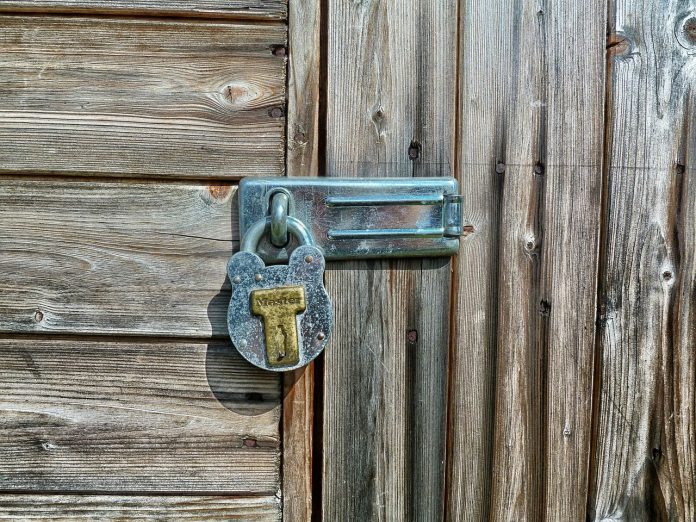1Planning a storage space
Storage space should be kept to a minimum to discourage storing too many unneeded pesticides, however, the space should be large enough to store all your chemicals including: newly purchased chemicals and opened containers, as well as used and unwanted chemicals, and empty containers until they can be properly disposed of.
2Storage site location
The best storage area would be a portable or prefabricated storage building, as it can be repositioned easily in case of a flood hazard. Locate a detached structure far enough away from other buildings and structures in case of a fire.
Pick an area that does not flood regularly. Water and moisture can cause metal containers to rust; disintegrate paper or cardboard packaging; make labels unreadable; cause labels to detach; cause dry formulations to clump or cake, break down, or dissolve and release pesticide; and cause pesticide to spread to other areas.
3Storage construction
Use materials that are nonflammable to build your structure. Use nonabsorbent materials, such as metal or nonporous shelving with a lip or leak-proof plastic trays on the shelves. Plastic trays can help organize products and act as secondary containment in case of a spill.
Use sealed floors, such as sealed concrete, epoxy-coated metal or concrete, no-wax sheet flooring, or other easily cleaned, nonabsorbent material. If possible, provide electrical power to the storage area to allow for internal lighting, an exhaust fan, and a heater, in addition to exterior security lighting and alarm.
4Storage environment
Keep the storage unit dry and well ventilated. Keep outside doors and windows closed and locked, unless windows are needed for ventilation. Windows should not be large enough for someone to enter through them.
Keep pesticides from freezing — most should be stored between 40 and 90 F; Read the label to be sure. Keep containers out of direct sunlight. Do not put containers, especially glass or aerosol containers, in windows even temporarily.
Next week: Pesticide security and safety.
Source: Pesticide storage and security, Penn State Extension.
(Farm and Dairy is featuring a series of “101” columns throughout the year to help young and beginning farmers master farm living. From finances to management to machinery repair and animal care, farmers do it all.)
More Farming 101 columns:
- 8 food safety tips for shopping at farmers markets
- 5 price strategies for farmers
- 5 price research resources for farmers
- How to price farm products
- How to keep your livestock cool
- How to create an irrigation schedule
- How to choose the right irrigation system
- Things to consider when burning agricultural waste
- What can you burn on the farm?
- 9 tips for better pasture management
- 7 safety tips for driving farm equipment on the road
- 5 things to know about farmland leases
- No-till planter in-field checklist
- How to prep a no-till planter part 2
- How to prep a no-till planter
- 7 considerations for gardening with high tunnels
- 9 basic considerations for backyard poultry
- 9 ways to grow your farm business
- 10 questions to ask before expanding the farm
- How to select quality replacement heifers
- Stay safe working with electricity on the farm
- How to create a job safety analysis
- Tips for a successful lambing season
- Do you have a vision for your farm?
- Cattle handling for beginners
- Should I buy a new or used tractor?
- How to inspect a used tractor before purchase
- How to buy the right tractor for your farm
- 5 tips for a better farm marketing plan
- How to seek help with retirement planning
- How to set goals for retirement
- A farmer’s guide to saving for retirement
- A farmer’s guide to planning for retirement
- 5 steps to get NRCS assistance
- How can conservation easements help you?
- How to fund conservation plans
- What is a conservation plan?
- How can NRCS help you?
- More airborne hazards on the farm
- 5 airborne hazards to beware of on the farm
- 5 things to know about Wagyu beef
- Pennsylvania utility vehicle laws
- Ohio utility vehicle laws
- Farm chemical safety checklist
- When should a farm become a business entity?
- Harvest prep: Check your yield monitors
- How to tag livestock properly
- 6 tips for decision making on a family farm
- 8 tips to prepare your farm for agritourism
- How to plan for farm emergencies
- 7 keys to success on the farm
- 7 tips for healthy fair animals
- 5 tips to ensure livestock health before the fair
- 6 tips to keep your livestock parasite free
- 6 tips for vaccinating your livestock
- 5 tips to prevent dairy cow foot problems
- 6 common foot problems found in dairy cows
- Recognize, prevent heat stress in dairy cattle
- How to monitor your dairy herd
- How to start your own dairy farm
- 5 tips for sun safety in the field
- Employing youth for the summer
- What to do if a hay fire occurs
- How to prevent hay fires
- How to extend the life of your fence
- 10 safety tips for installing electric fences
- How to chose the right fence for your farm
- How to create a fencing plan
- 7 steps for easy sprayer calibration
- Prepare for planting season, Part 2: Calibration
- Prepare for planting season, Part 1: The Basics
- 7 tips to improve security on your farm
- 5 tips to protect your farmland
- 3 measures to deal with severe farm debt
- How to buy time to catch up on farm debt
- 6 tips to manage income on the farm
- 5 tips to recognize and deal with farm stress
- How to prepare a livestock birthing kit
- 5 tips for marketing your farm
- How to develop farm mission, vision statements
- 5 tips for setting farm goals
- 2 types of livestock insurance policies
- 6 things you need to know about WFRP plans
- 3 basics of crop insurance
- How does liability insurance work on the farm?
- Why do I need farm insurance?
- How to understand and use Ohio’s CAUV
- How to utilize the Pa. Clean and Green Act
- 9 tips for filing farm taxes
- 8 reasons record keeping for taxes is essential
- 5 tips for post-harvest storage
- 7 tips for family meetings on the farm
- 4 tips for balancing your farm and family
- 4 tips for communicating on the family farm
- 4 tips for firing an employee
- 6 tips for keeping good farm help
- 4 tips for recruiting farm labor
- 5 general farm labor laws
- 4 tips for employing minors
- 4 tips for PTO safety
- 5 things young farmers should know about finances
- The farm balance sheet
- 5 items for your farm’s cash flow statement
- Personal and business records: Keep them separate
- What to include in your farm business plan
- How to approach a lender: Tips for getting a farm loan
- How to use microloans to get your farm started
- Saving for the future: 6 tips for young farmers
- How to create a farm safety kit
- 5 tips for child safety on the farm
- 4 tips for transporting livestock
- 5 ways to better understand tractor stability
- 6 farm equipment hacks












